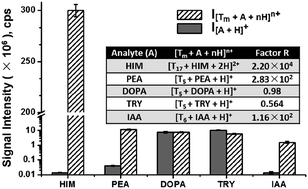Highly sensitive and specific detection of histamine via the formation of a self-assembled magic number cluster with thymine by mass spectrometry†
Abstract
A novel method for the detection of histamine (HIM) via the formation of a self-assembled magic number cluster with thymine (T) by electrospray ionization tandem mass spectrometry (ESI-MS/MS) is described. The formation of the magic number cluster [T17 + HIM + 2H]2+ shifts the MS signal of histamine to the interference-free higher mass range and the signal intensity is increased by four orders of magnitude. In addition, the formation of [T17 + HIM + 2H]2+ is highly specific to histamine compared with its metabolite and other similar biogenic amines, which may be attributed to both of its amino and imidazole groups. The linear dynamic range of the method is in the range of 1 nM–20 μM, and the limit of detection can be as low as 0.1 nM. The feasibility of this method is further demonstrated by the quantitative analysis of histamine in a red wine sample. Since little sample preparation or separation is required before the analysis, this method provides a rapid new way for the sensitive and specific detection of histamine by MS.


 Please wait while we load your content...
Please wait while we load your content...